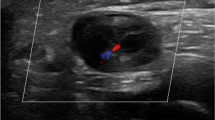Abstract
The surgical approach to the inguinal canal in girls is identical to that in boys. The sliding hernia which contains the ovary with or without the fallopian tube occurs occasionally in female patients. In our clinical experience, we found that a hydrocele in the labium, also presenting with an asymptomatic palpable movable mass, mimics a sliding hernia with ovary. In an attempt to differentiate between hydrocele and sliding inguinal hernia with ovary in female patients, we report our experience dealing with the two situations at a single institution within a 5-year period. Between July 1997 and June 2002, 1800 infants and children underwent surgery for inguinal hernia at Chang Gung Children's Hospital, of whom 580 were female infants and girls aged 1 month to 14 years (mean, 5.7 years). Some 32 patients (5.3%) presented with an asymptomatic palpable movable mass over the labium major. Pre-operative sonography was performed for all cases. Twenty-six female infants aged 1 month to 18 months (mean 5 months) had sliding hernia; both the ovary and fallopian tube were contained. Six girls aged 2 years to 6 years (mean 4.6 years), had hydrocele of the canal of Nuck. The accuracy of pre-operative diagnosis with sonography was 100%. Conclusion:sonography is an easy and accurate pre-operative diagnostic procedure. We suggest that sonography be performed routinely in all female cases with an inguinal hernia containing a palpable movable mass.



Similar content being viewed by others
References
Ando H, Kaneko K, Ito F, Seo T, Ito T (1997) Anatomy of the round ligament in female infants and children with an inguinal hernia. Br J Surg 84: 404–405
Foster MA, Nyberg RD, Mahony BS (1987) Meconium peritonitis: prenatal sonographic findings and their clinical significance. Radiology 165: 661–665
Goldstein IR, Potts WJ (1958) Inguinal hernia in female infants and children. Ann Surg 148: 819–822
Kapur P, Caty MG, Glick PL (1998) Pediatric hernias and hydroceles. Pediatr Clin North Am 45: 773–789
Kucera P, Glazer J (1985) Hydrocele of the canal of Nuck. A report of four cases. J Reprod Med 30: 439–442
O'Rahilly R, Muller F (1992) Human embryology and teratology. Wiley-Liss, New York, pp 219-221
Ozbey H, Ratschek M, Schimple G, Hollwarth ME (1999) Ovary in hernia sac: prolapsed or a descended gonad? J Pediatr Surg 34: 977–980
Potts WJ, Riker WL, Lewis JE (1950) The treatment of inguinal hernia in infants and children. Ann Surg 132: 566–576
Author information
Authors and Affiliations
Corresponding author
Rights and permissions
About this article
Cite this article
Huang, CS., Luo, CC., Chao, HC. et al. The presentation of asymptomatic palpable movable mass in female inguinal hernia. Eur J Pediatr 162, 493–495 (2003). https://doi.org/10.1007/s00431-003-1226-7
Received:
Revised:
Accepted:
Published:
Issue Date:
DOI: https://doi.org/10.1007/s00431-003-1226-7




